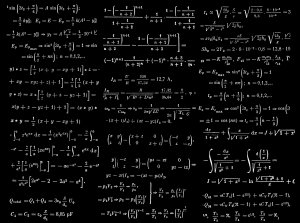Presented By: Dissertation Defense - Department of Mathematics
Dissertation Defense: One-dimensional Wave Kinetic Theory
Katja Vassilev

Dan Cristian Pădureț on Unsplash
Abstract:
Kinetic theory aims to write effective equations for the statistical laws arising in microscopic systems with many degrees of freedom. Such equations, referred to as kinetic equations, have been studied dating back to the Boltzmann equation in the late 1800's, and were later proposed for wave systems in the mid-1900's. Wave kinetic equations play an important role in the study of oceanography, plasma physics, and atmospheric science, to name just a few areas. Rigorous justification of these equations has been much more recent and falls under the umbrella of Hilbert's sixth problem.
Although wave kinetic equations have been rigorously derived in dimension d \geq $, both the physical and mathematical theory of wave turbulence in dimension d = 1 is less understood. Here, we look at the one-dimensional MMT (Majda, McLaughlin, and Tabak) model, a general model encompassing many dispersion relations \omega(k) = |k|^\sigma, where we consider 0 < \sigma < 2 and \sigma \neq 1. In particular, this includes the dispersion relations for the 1D cubic NLS (\sigma = 2) and gravity water waves (\sigma = 1/2). We restrict to the case where there are no derivatives in the nonlinearity, and consider the MMT on a large interval of length L with nonlinearity of size \alpha.
Here, we rigorously derive the kinetic equation in the kinetic limit L \to \infty and \alpha \to 0 under various scaling laws \alpha \sim L^{-\gamma} up to timescales T \sim L^{-\epsilon}\alpha^{-\frac{5}{4}} (or T \sim L^{-\epsilon} T_{kin}^{5/8}), where the kinetic time T_{kin} is the relevant timescale on which the kinetic approximation is expected. Notably, in the range of 1 < \sigma \leq 2, the proposed collision kernel of the kinetic equation is trivial, begging the question of what is the appropriate kinetic theory in that setting. In this case, our result implies there can be no nontrivial dynamics of the second moment up to timescales T_{kin}.
Kinetic theory aims to write effective equations for the statistical laws arising in microscopic systems with many degrees of freedom. Such equations, referred to as kinetic equations, have been studied dating back to the Boltzmann equation in the late 1800's, and were later proposed for wave systems in the mid-1900's. Wave kinetic equations play an important role in the study of oceanography, plasma physics, and atmospheric science, to name just a few areas. Rigorous justification of these equations has been much more recent and falls under the umbrella of Hilbert's sixth problem.
Although wave kinetic equations have been rigorously derived in dimension d \geq $, both the physical and mathematical theory of wave turbulence in dimension d = 1 is less understood. Here, we look at the one-dimensional MMT (Majda, McLaughlin, and Tabak) model, a general model encompassing many dispersion relations \omega(k) = |k|^\sigma, where we consider 0 < \sigma < 2 and \sigma \neq 1. In particular, this includes the dispersion relations for the 1D cubic NLS (\sigma = 2) and gravity water waves (\sigma = 1/2). We restrict to the case where there are no derivatives in the nonlinearity, and consider the MMT on a large interval of length L with nonlinearity of size \alpha.
Here, we rigorously derive the kinetic equation in the kinetic limit L \to \infty and \alpha \to 0 under various scaling laws \alpha \sim L^{-\gamma} up to timescales T \sim L^{-\epsilon}\alpha^{-\frac{5}{4}} (or T \sim L^{-\epsilon} T_{kin}^{5/8}), where the kinetic time T_{kin} is the relevant timescale on which the kinetic approximation is expected. Notably, in the range of 1 < \sigma \leq 2, the proposed collision kernel of the kinetic equation is trivial, begging the question of what is the appropriate kinetic theory in that setting. In this case, our result implies there can be no nontrivial dynamics of the second moment up to timescales T_{kin}.

Dan Cristian Pădureț on Unsplash